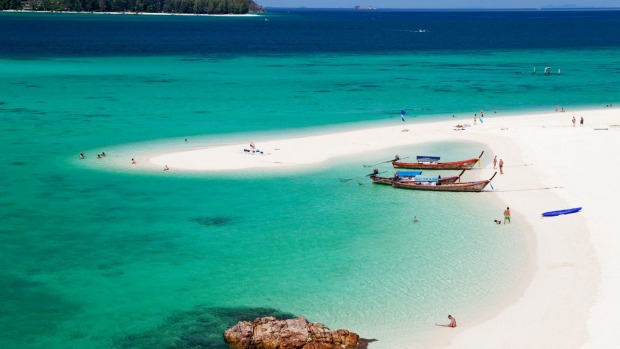
It was once an Asian version of Devil's Island, the French hellhole prison off South America, of Papillon and the Dreyfus Affair infamy. Thailand's equivalent was Koh Tarutao, a malaria-wracked, crocodile-infested island out in the Andaman Sea.
And then things went truly bad. When vital food supplies from the mainland were reduced to almost nothing, the guards and starving convicts on Koh (Island) Tarutao turned rogue, together, and became pirates. All this was within living memory.
I catch up on reading about this bizarre tale that happened during World War II while the speedboat I'm on rockets out from the southern Thailand port of Pak Bara, heading for Koh Tarutao. It's an almost cinematic tale of criminals, aristocrats, corruption, brigandry and finally, of commandos.
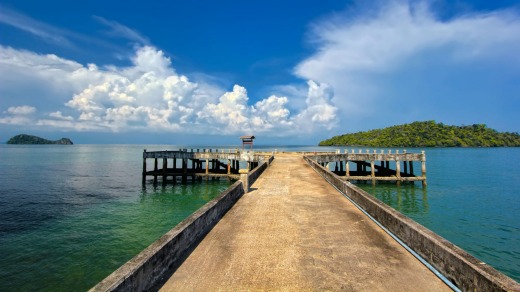
The Mu Koh Tarutao-Koh Adang archipelago, site of Thailand's second Marine National Park, established in 1974, is a scattering of 52 islands that are lush with unlogged rainforests and looped with empty, endless beaches. Monitor lizards, sea eagles, tree pythons and crab-eating macaques hold sway here more than humans do. The crocodiles, however, are now gone – probably dispatched by the hungry prisoners.
Jumping ashore after the two-hour trip, I find myself on the untrammeled beach of Ao Phante Malacca where there is not an ATM, resort spa, beer bar, tailor's tout or jet-ski to be seen. Instead, Koh Tarutao, the archipelago's namesake island, is a zone of casuarinas, jungle peaks and just one narrow road with no cars on it – the extreme opposite to other, overcooked Thai tourist islands. I like that "Tarutao" is a Thai derivation of the island's original Malay name, Pulau Tertua — "the island of old and mysterious."
Between 1938 and 1949, up to 3000 Thai convicts at a time were incarcerated on Koh Tarutao. A 30-kilometre moat of Andaman tides, sharks and crocodiles separated them from the mainland; meanwhile on the island many died of maltreatment and rampant malaria.
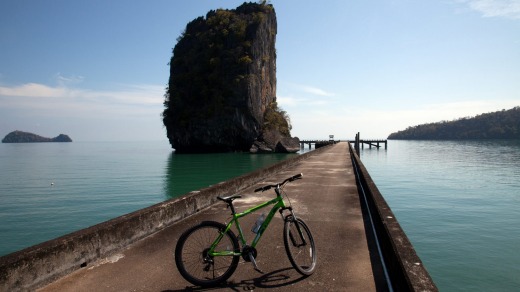
During World War II Thailand was occupied by Japan. As the tide turned against the Japanese their administration suffered crippling shortages and they began cutting supplies of rice and other staples to the remote prison island. Starvation set in and prisoners resorted to begging from coastal trading boats in the nearby Straits of Malacca.
The charity of the Malayan captains inevitably dried up. In 1944 the prisoners, by now in cahoots with their own guards, turned from begging to armed piracy. Their raids on boats became increasingly violent and, in order to hide the evidence, the pirates burned the vessels and murdered crews. They became so successful at pillaging that the guards began selling their booty for profit on the mainland.
Today the Tarutao-Adang islands are a wilderness of silica sands and limestone cliffs, mangroves and a bottle-glass sea, turtles and langurs. If all seems like a set for television's Survivor, that's because it was: the 2002 series, Survivor: Thailand was shot here.
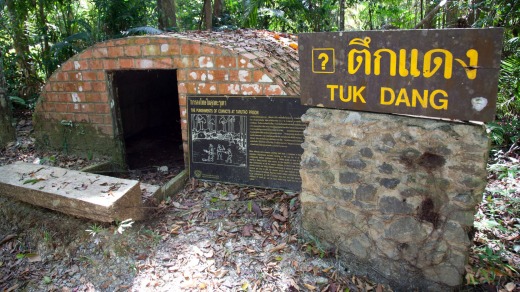
Visitors to Koh Tarutao, the archipelago's largest island (at 152 square kilomtres), can rent basic bungalows near the National Park headquarters at Phante Malacca Bay and also on the Edenic west coast beaches of Ao Molae and Ao Son. Young Thais and foreign backpackers often hire tents from the park office and camp under the stars and casuarinas wherever their inner Robinson Crusoe reckons.
My cabin on the beachfront at Ao Molae costs around $20 a night and is far from flash, but still adequate. It has a decrepit but functioning bathroom, a double bed with a mozzie net and, booming intermittently through the night up in the rafters, an extraordinarily loud gecko. We have five hours of generator electricity each night, with lights out at eleven.
Ao Molae is a half-kilometre, half-moon arc of barefoot adventure and an Indian Ocean horizon. No celebrities here to tweet about, just sand, moon, stars, fishing boats and a wall of jungle surrounding it all – Thailand, the original, the unplugged. Ditch the device. Bring a good book or a friend, or both. Tucked in among the shoreline trees are 20 bungalows and an open-air, canteen-style eatery that's good for beer and Thai food. The boss rents mountain bikes for a few dollars a day.
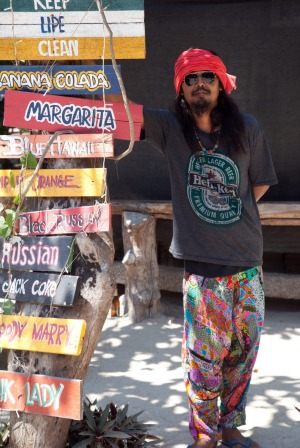
I head out one morning on the single-lane, 20-kilometre concrete path that winds up, over and around the island's hills and their dense, old-growth forest. A two-metre monitor the size of a crocodile suns itself in the road. I do a double take to make sure it isn't a crocodile. After 12 sweaty kilometres I pedal into Ao Thalo Wow bay on the east coast where the main prison stood. The original structures that once housed some 2000 inmates are long gone, devoured by the jungle or looted after the prison closed in 1948. Well-kept concrete walkways lead today's visitors through the old prison site. Of several reconstructed buildings, the one to give claustrophobes the most creeps is a low, dark, solitary confinement pit where prisoners could only lie, not stand.
Illustrated signs tell the tale of daily life and death in this tropical purgatory. One depicts a punishment in which a prisoner had to carry a heavy ship's anchor until he dropped from exhaustion. The caption explains that, over time, the wily cons began hollowing out the part-wooden anchor to make it, and their punishments, lighter. Realising the scam, the guards replaced it with an all-concrete anchor.
Among the prisoners was a group of 70 Thai political rebels – military officers and aristocrats – exiled to Tarutao after a failed Bangkok palace coup in the 1930s. They were housed separately at Talo Udang Bay in the south of the island and were not part of the piracy raids. Some filled the time with their version of "desert island discs" pursuits. One, a grandson of King Rama VII, turned his regal green thumb to developing a new cucumber variety during his term.
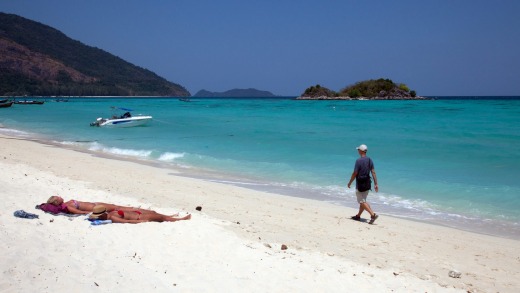
Another, So Setabutra, compiled the first Thai–English dictionary. His phrasebook has sections such as In the Ball-Room, On a Tricycle and In a Beer Hall, while conversational icebreakers of the day included, "Are you an officer?", "Where did you fight?" and "Can you take me to see a woman?" To greet someone, according to the book, you just gave a best-of-British, "Hullo, old chap!"
"Hell. I can't get a phone signal," despairs a newly arrived European traveller while her pad thai noodles go cold and her beer gets warm. It's sunset and we're having dinner around a table at the Ao Molae eatery. "So, now the definition of hell is heaven without WiFi?" chortles a more seasoned visitor.
From the socially un-mediated shores of Tarutao I can't see the bright lights of Lipe Island in adjacent Koh Adang archipelago but that will be my next port of call. After Tarutao's character-building early nights and biking-hiking-swimming days, the contrast at Koh Lipe (pronounced Lee-pae) promises to either appeal or appall, perhaps both.

An hour's speedboat zip south of Tarutao I step on to Lipe's busy Pattaya Beach. Its name, the same as Thailand's most neon, most anything-goes resort city, might give rise to apprehension in a visitor who's accustomed mostly to nocturnal cricket-trills and gecko honk. But the name Pattaya is in fact a derivation from Phatthaya, that benignly means, "the wind that comes from south west". So, no go-go bars. Well, not yet.
Along with the other Thai, Chinese and European tourists who splash ashore on Koh Lipe, I am soon funneled into its gauntlet known as Walking Street that runs right across the tiny island. Pizza, latte, convenience stores, dive shops, ATMs, cool bars and people come at me. The side sois are alive with seafood restaurants, trinket stalls and lodges. There's not a macaque or monitor in sight. Instead, it's gappers and rappers and little motorbike taxis. Ornithology here would be The Eagles rather than sea eagles. But the place is fun, immediately.
Koh Lipe — the name means "Paper Island" in the language of its chao lay or "sea gypsy" dwellers – is the only island in the archipelago that was not included in the national park. As Thailand's southernmost inhabited island, Lipe was already home to some 500 sea gypsies who were granted land on its eastern shore, Sunrise Beach. During the years they've leased much of it, often cheaply, to resort developers and now are fighting to retain access to the little that they still control.
"Koh Lipe, the Maldives of Thailand," says a brochure that I pick up on Walking Street. Well, perhaps, insofar as there are plenty of scattered islands and the azure shallows seem too clear to be true. But mostly, no. The 30 or so islands that surround Lipe are untamed jungle upthrusts rather than low-rise Maldivian cays topped by opulent resorts. What the two places have in common is great diving and snorkelling, with the marine park here probably winning out by being home to an estimated 25 per cent of the world's tropical fish species.
All that is ahead of me. I find a room at a dive lodge that has showers with hot water, a walk-out reef just off the beach and burning sunsets at the end of the street. Devil's Island was never like this. There's even WiFi.
So, what happened in the end to the pirates of Tarutao? Even after the Pacific war finished in August 1945, and despite the bitter outcry from Malay and Chinese traders in Langkawi and Penang, they continued their raids. The new Thai government was impotent to stop them and it was only the forceful intervention in March 1946 of a 300-strong group of British Royal Navy commandos that crushed the looters. The former prison governor received a 15-year jail sentence – and not on his own island.
The writer was a guest of the Tourism Authority of Thailand.
kotarutaothailand.com; kohlipe.net
Fly to Bangkok direct from Sydney and Melbourne with Thai Airways . National Park entry, 200 baht.
Season: Koh Tarutao and other National Park islands are closed during monsoon, November-April, but Koh Lipe remains partly open.
Koh Tarutao: Book bungalow accommodation (600 baht/night) or hire tents (250 baht/night) through Thai National Parks .
Koh Lipe: Adang Sea Divers Lodge, Sunrise Beach. Open all year. Five small, double-bed, fan rooms. Private bathroom with hot/cold shower; towels provided. Seasonal room prices from 800—2000 baht/night (adangseadivers.com; +66 807041633).
Climb Toe-Boo Cliff above Ao Phante Malacca for a fine Andaman Sea view, then join a Crocodile Cave tour aboard a long-tailed boat, seeing stalactites, stalagmites and mangrove forests, but no crocs.
Curl up in a hammock with Thai novelist Paul Adirex's Pirates of Tarutao, a fanciful, fictional version of the grim events that happened on the island in the 1940s.
Hire a mountain bike for 250 baht/day at Ao Phante Malacca or Ao Molae. Explore Koh Tarutao's concrete road, branching off to deserted beaches or the old prison site at Ao Thalo Wow.
From Koh Lipe, join a speedboat daytrip tour of surrounding islands like Hin Sorn, Dong, Rawi, Adang and Hin Ngam. Snorkelling gear and lunch included for 2000 baht; with Paradise Tours Koh Lipe. paradisetourslipe.com.
On Koh Lipe, do a PADI course (from 10,500 baht) or fun dive (2500 baht) with Adang Sea Divers. See adangseadivers.com.